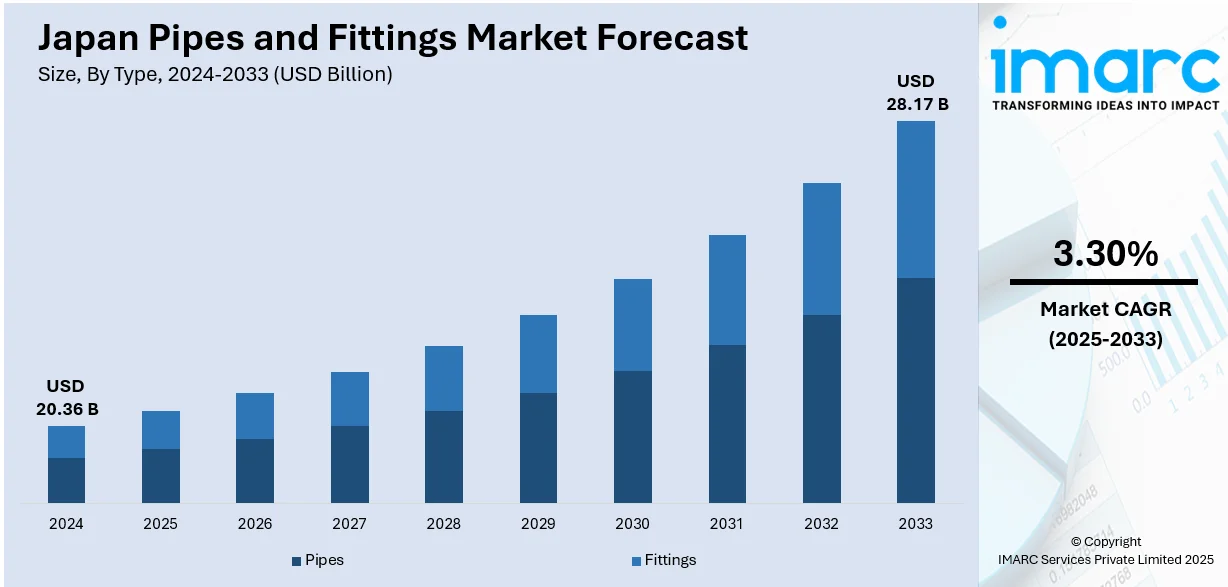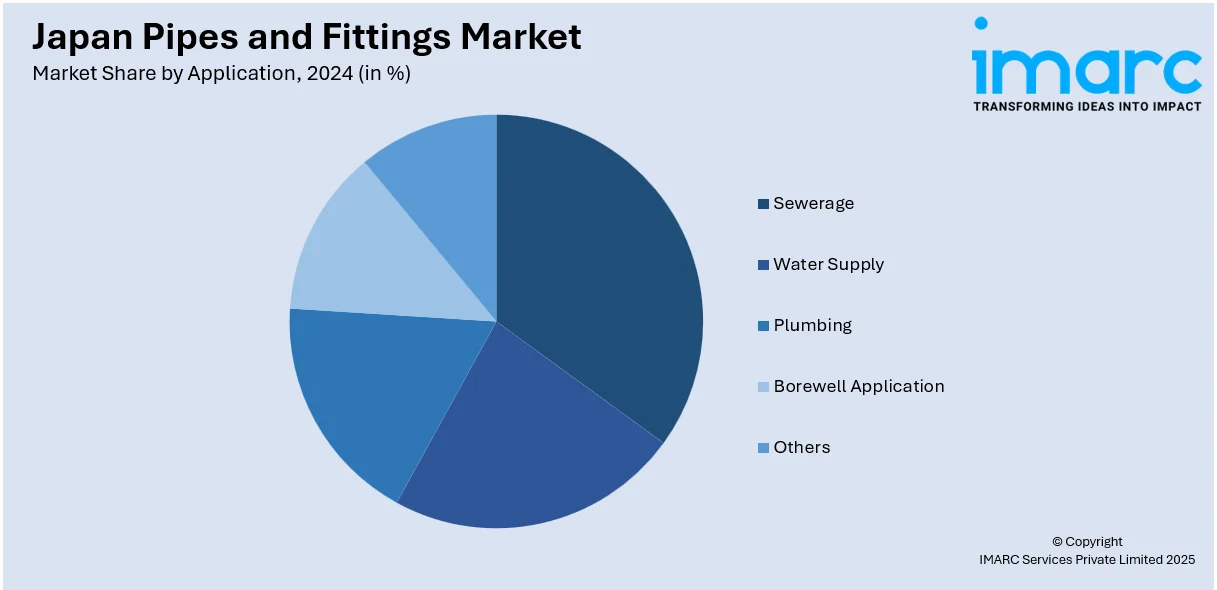
Japan Pipes and Fittings Market Size, Share, Trends and Forecast by Type, Technology, Application, Vertical, and Region, 2025-2033
Japan Pipes and Fittings Market Overview:
The Japan pipes and fittings market size reached USD 20.36 Billion in 2024. Looking forward, IMARC Group expects the market to reach USD 28.17 Billion by 2033, exhibiting a growth rate (CAGR) of 3.30% during 2025-2033. The market is transforming rapidly as a result of rising use of plastic piping systems, jointing techniques innovation, and large-scale infrastructure renewal. All these trends mirror an overall focus on efficiency, longevity, and sustainability in residential, municipal, and industrial use. Developments in material performance and digitalization are also further enhancing pipeline reliability and lifecycle management. Further investment in earthquake-resistant and intelligent infrastructure will further drive sectoral growth, thus increasing the overall Japan pipes and fittings market share.
|
Report Attribute
|
Key Statistics
|
|---|---|
|
Base Year
|
2024 |
|
Forecast Years
|
2025-2033
|
|
Historical Years
|
2019-2024
|
| Market Size in 2024 | USD 20.36 Billion |
| Market Forecast in 2033 | USD 28.17 Billion |
| Market Growth Rate 2025-2033 | 3.30% |
Japan Pipes and Fittings Market Trends:
Increased Demand for High-Performance Plastic Piping Options
There has been a trend in Japan towards high-performance plastic pipes including polyvinyl chloride (PVC), chlorinated polyvinyl chloride (CPVC), and cross-linked polyethylene (PEX). They have better benefits compared to conventional metal piping, such as corrosion resistance, low handling weight, and quick installation. Their demand keeps growing because they are used in residential plumbing, wastewater systems in industries, and heating, ventilation, and air conditioning (HVAC) pipelines. Moreover, plastic piping systems comply with sustainability goals based on their longer lifespan, recyclability, and low carbon footprint during production and transportation. Their cost-effectiveness and design flexibility further add to their appeal for both new construction and renovation projects. The Japanese government’s emphasis on energy efficiency and modernized infrastructure is accelerating the adoption of non-metallic piping systems. These dynamics collectively reinforce Japan pipes and fittings market growth, positioning plastic-based systems as a long-term solution for durable and sustainable pipeline infrastructure.

To get more information on this market, Request Sample
Integration of Advanced Jointing Technologies and Smart Monitoring
Japan's pipe fitting environment is changing with the incorporation of new jointing methods like electrofusion, butt welding, and compression fittings. They minimize leakage, provide secure connections, and enable efficient assembly of complex networks of pipelines. The need is particularly felt in municipal water, industrial process, and utility applications where reliability and extended lifetime are critical. Pipe networks are also increasingly embracing smart technologies, including pressure sensors and digital flow meters, to facilitate real-time diagnosis and predictive maintenance. All these advancements are part of Japan's larger digital infrastructure plan aimed at increasing operational efficiency and system integrity. By integrating automation and precision engineering in pipe and fitting assemblies, infrastructure is made stronger and responsive to changing usage conditions. The take-up of these innovations is a measure of changing Japan pipes and fittings market trends, with actors converging on performance, safety, and data-driven maintenance in today's fluid transport and distribution systems. For instance, in May 2024, when NTT announced a breakthrough in high‑precision measurement of underground pipelines, using integrated TOF (time‑of‑flight) cameras, gyro sensors, and encoders to create a digital twin with under 0.10% error—allowing three‑dimensional visualization of buried conduits. This development is crucial for ensuring the integrity and safety of pipe networks, highlighting Japan’s commitment to digitalization in pipeline infrastructure.
Infrastructure Modernization Fueling Demand for Long-Lasting Piping Systems
Japan's aggressive infrastructure modernization initiatives like, earthquake-resistant utilities, replacement of aging pipelines, and water conservation are fueling the demand for long-lasting pipes and high-performance fittings. With urban cities needing immediate upgrades to old systems, there is increasingly widespread deployment of ductile iron, stainless steel, and composite materials that can resist environmental stress as well as seismic activity. Especially, Tokyo, Osaka, and other metropolitan cities' water and sewage systems are being retrofitted to an extent in order to achieve contemporary performance standards and regulatory requirements. At the same time, growing investment in smart cities, energy schemes, and public transit is driving demand for highly engineered piping systems that enable advanced fluid control. This evolution is encouraging the use of smart valves and flexible types of fittings that can be operated remotely and serviced efficiently. These infrastructure-oriented strategies are not only enhancing system reliability but are also among the most important drivers of Japan pipes and fittings market growth, fueled by strategic long-term planning.
Japan Pipes and Fittings Market Segmentation:
IMARC Group provides an analysis of the key trends in each segment of the market, along with forecasts at the country and regional levels for 2025-2033. Our report has categorized the market based on type, technology, application, and vertical.
Type Insights:
- Pipes
- Plastic Pipes
- Metallic Pipes
- Others
- Fittings
- Elbow
- Reducer
- Tee Type
- Cross Type
- Coupling
- Union
- Adaptor
- Valve
- Cap
- Others
The report has provided a detailed breakup and analysis of the market based on the type. This includes pipes (plastic pipes, metallic pipes, and others), and fittings (elbow, reducer, tee type, cross type, coupling, union, adaptor, valve, cap, and others).
Technology Insights:
- Compression Molding
- Injection Molding
- Thermoforming
- Extrusion
- Electro Fusion
- Fabricated
- Others
A detailed breakup and analysis of the market based on the technology have also been provided in the report. This includes compression molding, injection molding, thermoforming, extrusion, electro fusion, fabricated, and others.
Application Insights:

- Sewerage
- Water Supply
- Plumbing
- Borewell Application
- Others
The report has provided a detailed breakup and analysis of the market based on the application. This includes sewerage, water supply, plumbing, borewell application, and others.
Vertical Insights:
- Chemical and Petrochemical
- Residential
- Commercial
- Transportation
- Municipal
- Food and Beverage
- Oil and Gas
- Power
- Process Instrumentation
- Semiconductor
- Irrigation
- HVAC
- Others
A detailed breakup and analysis of the market based on the vertical have also been provided in the report. This includes chemical and petrochemical, residential, commercial, transportation, municipal, food and beverage, oil and gas, power, process instrumentation, semiconductor, irrigation, HVAC, and others.
Regional Insights:
- Kanto Region
- Kansai/Kinki Region
- Central/ Chubu Region
- Kyushu-Okinawa Region
- Tohoku Region
- Chugoku Region
- Hokkaido Region
- Shikoku Region
The report has also provided a comprehensive analysis of all the major regional markets, which include Kanto Region, Kansai/Kinki Region, Central/Chubu Region, Kyushu-Okinawa Region, Tohoku Region, Chugoku Region, Hokkaido Region, and Shikoku Region.
Competitive Landscape:
The market research report has also provided a comprehensive analysis of the competitive landscape. Competitive analysis such as market structure, key player positioning, top winning strategies, competitive dashboard, and company evaluation quadrant has been covered in the report. Also, detailed profiles of all major companies have been provided.
Japan Pipes and Fittings Market News:
- In June 2025, Japanese firms such as JFE Pipe Fitting and Nihon Tsugugi introduced advanced pipe fittings with precision casting and rapid couplings. The market is expected to expand fast due to innovations in steel and resin materials that fulfill growing demand for long-lasting, high-performance piping technology in industrial and housing markets.
Japan Pipes and Fittings Market Report Coverage:
| Report Features | Details |
|---|---|
| Base Year of the Analysis | 2024 |
| Historical Period | 2019-2024 |
| Forecast Period | 2025-2033 |
| Units | Billion USD |
| Scope of the Report |
Exploration of Historical Trends and Market Outlook, Industry Catalysts and Challenges, Segment-Wise Historical and Future Market Assessment:
|
| Types Covered |
|
| Technologies Covered | Compression Molding, Injection Molding, Thermoforming, Extrusion, Electro Fusion, Fabricated, Others |
| Applications Covered | Sewerage, Water Supply, Plumbing, Borewell Application, Others |
| Verticals Covered | Chemical and Petrochemical, Residential, Commercial, Transportation, Municipal, Food and Beverage, Oil and Gas, Power, Process Instrumentation, Semiconductor, Irrigation, HVAC, Others |
| Regions Covered | Kanto Region, Kansai/Kinki Region, Central/Chubu Region, Kyushu-Okinawa Region, Tohoku Region, Chugoku Region, Hokkaido Region, Shikoku Region |
| Customization Scope | 10% Free Customization |
| Post-Sale Analyst Support | 10-12 Weeks |
| Delivery Format | PDF and Excel through Email (We can also provide the editable version of the report in PPT/Word format on special request) |
Key Questions Answered in This Report:
- How has the Japan pipes and fittings market performed so far and how will it perform in the coming years?
- What is the breakup of the Japan pipes and fittings market on the basis of type?
- What is the breakup of the Japan pipes and fittings market on the basis of technology?
- What is the breakup of the Japan pipes and fittings market on the basis of application?
- What is the breakup of the Japan pipes and fittings market on the basis of vertical?
- What is the breakup of the Japan pipes and fittings market on the basis of region?
- What are the various stages in the value chain of the Japan pipes and fittings market?
- What are the key driving factors and challenges in the Japan pipes and fittings?
- What is the structure of the Japan pipes and fittings market and who are the key players?
- What is the degree of competition in the Japan pipes and fittings market?
Key Benefits for Stakeholders:
- IMARC’s industry report offers a comprehensive quantitative analysis of various market segments, historical and current market trends, market forecasts, and dynamics of the Japan pipes and fittings market from 2019-2033.
- The research report provides the latest information on the market drivers, challenges, and opportunities in the Japan pipes and fittings market.
- Porter's five forces analysis assist stakeholders in assessing the impact of new entrants, competitive rivalry, supplier power, buyer power, and the threat of substitution. It helps stakeholders to analyze the level of competition within the Japan pipes and fittings industry and its attractiveness.
- Competitive landscape allows stakeholders to understand their competitive environment and provides an
Need more help?
- Speak to our experienced analysts for insights on the current market scenarios.
- Include additional segments and countries to customize the report as per your requirement.
- Gain an unparalleled competitive advantage in your domain by understanding how to utilize the report and positively impacting your operations and revenue.
- For further assistance, please connect with our analysts.
 Request Customization
Request Customization
 Speak to an Analyst
Speak to an Analyst
 Request Brochure
Request Brochure
 Inquire Before Buying
Inquire Before Buying




.webp)




.webp)












